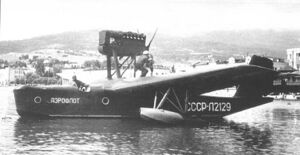Engineering:Beriev MBR-2
The Beriev MBR-2[1] was a Soviet multi-purpose (including reconnaissance) flying boat which entered service with the Soviet Navy in 1935. Out of 1,365 built, 9 were used by foreign countries including Finland and North Korea. In Soviet Union it sometimes carried the nickname of "Kорова" (cow) and "Амбар" (barn).[2]
Design
The MBR-2 was designed by Georgy Mikhailovich Beriev and first flew in 1931, powered by an imported 373 kW (500 hp) BMW VI.Z engine. Production models, which arrived in 1934, used a licence-built version of this engine, the Mikulin M-17 of 508 kW (680 hp), and could be fitted with a fixed wheel or ski undercarriage.
Beriev also designed a commercial airliner derivation, the MP-1, which entered airline service in 1934, and a freighter version, which followed in 1936.
In 1935, an improved version was developed, the MBR-2bis, powered by the Mikulin AM-34N engine, and fitted with an enclosed cockpit, dorsal gun-turret and enlarged vertical tail. In this configuration, the machine remained in production until 1941. As with the MBR-2, the bis spawned a commercial derivative and the MP-1bis entered service in 1937.
Variants
- MBR-2M-17 : Short-range maritime reconnaissance, bombing flying-boat, powered by a 508 kW (680 hp) Mikulin M-17B piston engine.
- MBR-2AM-34 or MBR-2bis : Improved version, powered by a Mikulin AM-34N engine.
- MBR-2M-103 : One MBR-2AM-34 was fitted with the more powerful M-103 engine. One prototype only.
- MP-1 : Civil version of the MBR-2M-17 flying-boat. It could carry six passengers in an enclosed cabin.
- MP-1bis : Civil version of the MBR-2AM-34 flying-boat.
- MP-1T : Freight transport conversion of MBR-2.
Operators
 Finland
Finland
- The Finnish Air Force operated five captured aircraft from 1941.
 Soviet Union
Soviet Union
- Aeroflot
- Soviet Naval Aviation
 North Korea
North Korea
Specifications (MBR-2 AM-34)
Data from L'hydroaviation MBR-2, pillier de la reconnaissance naval soviétique[3]
General characteristics
- Crew: 4-5[4]
- Length: 13.50 m (44 ft 3 in)
- Wingspan: 19.00 m (62 ft 4 in)
- Height: 5.00 m (16 ft 5 in)
- Wing area: 55 m2 (590 sq ft)
- Airfoil: root: MOS-27 (18%); tip: MOS-27 (10%)[5]
- Empty weight: 2,718 kg (5,992 lb)
- Gross weight: 4,245 kg (9,359 lb)
- Powerplant: 1 × Mikulin AM-34NB V-12 liquid-cooled piston engine, 620 kW (830 hp)
Performance
- Maximum speed: 275 km/h (171 mph, 148 kn) at 5,000 m (16,000 ft)
- Cruise speed: 190 km/h (120 mph, 100 kn)
- Range: 1,600 km (990 mi, 860 nmi)
- Service ceiling: 6,000 m (20,000 ft)
Armament
- Guns:
- 1× 7.62 mm (0.30 in) PV-1 machine gun in bow
- 1× 7.62 mm ShKAS machine gun in dorsal turret
- Bombs:
- 300 kg (660 lb) of bombs, mines, and depth charges carried underwing[4]
See also
Aircraft of comparable role, configuration and era
Related lists
References
- ↑ MBR stands for its Russian role - Morskoi Blizhniy Razvedchik (Cyrillic: Морской Ближний Разведчик) "Naval Short Range Reconnaissance".
- ↑ Bogatko, Sergei. Recce's of tradeways
- ↑ Kulikov Avions September 1998, p. 28
- ↑ 4.0 4.1 Green 1968, p. 140
- ↑ Lednicer, David. "The Incomplete Guide to Airfoil Usage". https://m-selig.ae.illinois.edu/ads/aircraft.html.
Bibliography
- Green, William (1968). War Planes of the Second World War, Volume Five, Flying Boats. London: Macdonald & Co. (Publishers) Ltd.. ISBN 0-356-01449-5.
- Kulikov, Victor (September 1998). "L'hydroaviation MBR-2, pillier de la reconnaissance naval soviétique" (in French). Avions: Toute l'aéronautique et son histoire (66): 22–29. ISSN 1243-8650.
- Munson, Kenneth (1969). Bombers, Patrol and Transport Aircraft 1939-45. Blandford. ISBN 0-7137-0379-2.
External links
- Beriev MBR-2 at aeroflight.co.uk
- Century of Flight
- Beriev MBR-2, TsKB-25 (project and prototype) at Russian Aviation Museum
- MBR-2 series with M-17 engine at Russian Aviation Museum
- Beriev MP-1, MP-1bis, MP-1T (civilian variant) at Russian Aviation Museum
 |


